The Current Trend in Japan's Adaptive Fashion
text by Ai Kishino
Japan is widely thought of as a country with a strong public health-care system, where residents are less concerned about common illnesses and injuries than in other countries. Japan, however, has long lagged European countries and the United States in its awareness about services for disabilities. This awareness has been slowly improving over the past few years, thanks to the efforts of activists, the accomplishments of the athletes in the 2020 Paralympic Games in Tokyo, and popular TV shows that feature characters with disabilities played by well-known actors. Also drawing more attention to disabilities in Japan is adaptive fashion, which is seen more frequently on social media. We interviewed three people who have been studying the relationship between people with disabilities and fashion to find out what they’ve discovered by questioning how fashion should be.
Japan Persons with Disabilities Fashion Association Representative
Kei Hirabayashi
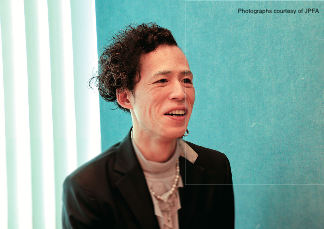
A “bottom’all” can be easily put on and instantly removed with a fabric fastener around the waist, showing off its stylish design. This highly functional and fashionable skirt-like bot- tom can be worn regardless of age, disabilities, and gender. It was produced by Kei Hirabayashi, who drew a lot of attention when releasing this product. Last year, he hosted a fashion show in Paris that featured models in wheelchairs. What is Hirabayashi’s vision for the future of adaptive fashion?
TJ: What inspired you to showcase the bottom’all at Paris Fashion Week?
HIRABAYASHI: In 2019, when I was having a meal with my friend, I was asked, “Did you know that a model in a wheelchair has never walked a Paris Fashion Week runway?” Back then, I was thinking that my mission was “to make people’s impression toward disabilities and the field of welfare brighter and more radiant through fashion,” so when I was asked this, I thought, “No way!” and I immediately did some research. Turned out, it was really true. The sustainable development goals were already popular in the media at that time, so I was shocked, and I thought to myself, “Wow, there is still such a gap between the goals set by the world and the true reality.” I also thought, “The world won’t change just by having a model in a wheelchair walk down the Paris Fashion Week runway.” Hosting a fashion show with designs that are fashionable just because they are in a wheelchair instead of being fashionable even in a wheelchair would create a reverse phenomenon in which disability itself becomes stylish and would lead to making a small change in the world. This will also make it meaningful for the model to challenge themselves, who sacrifice their time and lives. I immediately started working toward this goal the very next day, and in November of that same year, I established Japan Persons with Disabilities Fashion Association ( JPFA), and this is how it all started.
TJ: What was the process like to the day of the show?
HIRABAYASHI: First, I looked for people who could make clothes. I could picture what kind of clothes I wanted to make, but I had no experience in actually making them. Amazingly, people willing to support gathered around me. However, the next year was 2020, when we had to stop our project due to the coronavirus pandemic, so we actually started making clothes in 2021. We continued through trial and error. At the same time, we spent a year deciding on the site to host our show and we finally accomplished this last year. We struggled with our budget and planning of the location, almost giving up three times. I think it actually helped that we started without any knowledge about making clothes and Paris Fashion Week. I think we were able to have more than 100 people support our project because they sympathized with our passion and our will to move toward our goal even if we had zero knowledge of Paris Fashion Week and no experience in making clothes. Well, it might have been more like a worry that the supporters felt toward us, thinking, “Oh no, they don’t know what they’re doing!” Like parents concerned about their child.
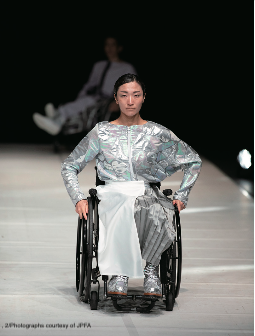
TJ: Even though the coronavirus pandemic was unpredictable, wasn’t it frustrating to be forced to pause right when you were about to take action?
HIRABAYASHI: Now that I think about it, the time when we couldn’t do anything was also necessary. Until then, we were just forcing our way through, so during the pandemic, I was able to talk with the members involved in creating the bottom’all about how we should share our intention behind our project. This was when the concept that we still hold onto, Next UD (Universal Design), was produced. I felt that Universal Design typically focuses only on usability by providing designs that are accessible and easy to use by anyone. We believe that we can add more entertainment to bring on the next generation of Universal Design.
TJ: Could you share how you felt or what you discovered when you actually conducted the fashion show?
HIRABAYASHI: It was really fun. I went to Paris with the intention to turn zero into a one, but to be honest, I feel that we were only able to make zero into 0.1. We received great responses, but we felt that there was more to work on. But because of this experience, our current objective, which is to create the Next UD Collection, emerged as well. The Paris Fashion Week we participated in is one of the “Big Four” fashion events in the world, but I heard that there has still not been a fashion show that is dedicated to Universal Design. Achieving such a show, I think, is when we can finally turn the 0.1 we have produced into a one. We have already begun moving toward this goal. I cannot say exactly what we are doing, but we hope we can show you something fascinating.
TJ: What are your thoughts on challenges for adaptive fashion in Japan and the prospects on Japanese society?
HIRABAYASHI: Similar to adaptive fashion, I imagine that there will be a revolution in fashion for kaigo (nursing) clothing. I think so because those who experienced the 1980s trend of designer and character brands in Japan will be in the life stage where they need nursing care. If those stylish people, who were wildly excited about such fashion trends in the past, were asked whether they will choose the nursing clothes available right now which are only focused on functionality, they would probably say no. I would not like to wear them myself either. That means that the clothes we are making right now is equal to making what we can easily wear in the future when we age and cannot move certain parts of our bodies. When we get older, our legs stop moving and we cannot move ourselves freely. That means there would be people choosing to use wheelchairs, which would make the wheelchair no longer equipment for only those with disabilities. I think the field of disabilities and nursing care are very similar.
TJ: Your project extends beyond adaptive fashion, creating a whole new option in the world.
HIRABAYASHI: I think having options is what makes the world a healthy place. Our ultimate goal is to make Next UD clothes perme- ate more in society. We want to let the clothes you happened to grab to be clothes that can be worn freely without anyone’s help, and yet also stylish. I am not saying that every single item of clothing has to be like that. But I want to make a society with more availability of choices, and I believe such a time will come.
Marusankakushikaku Corporation CEO
Sae Fukui
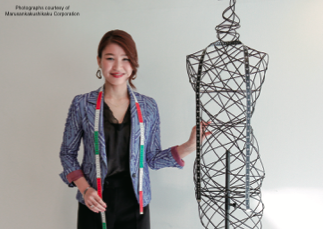
Sae Fukui is a tailor who takes the characteristics of each per- son’s body into sincere consideration, tailoring one-and-only suits for every customer. How are the strengths of tailor-made suits utilized for tailoring suits for people with disabilities, and what kind of suits have been produced? Learning about her career and her ideals as a tailor, we start to see what she wants to convey and the society she wants to achieve through her work.
TJ: Did your prolonged experience with atopic eczema lead you to start your career as a tailor?
FUKUI: Yes. I used to feel, “My body is not what I think it is. It’s different from others. Why does she have a beautiful body while mine is so ugly?” I hated my life and my parents who brought me to the world. My case of eczema was the type that got worse as I got older, so there was a time when I seriously thought, “It’s better to die if I have to continue into adulthood like this.” However, I was fortunate to overcome the condition in my early thirties, and when I was 34, I started my career as a self-employed tailor. Then I thought to myself, “What do I want to do for society through tailoring?” I looked back at my own past and thought, “I want to let every person know that their life is beautiful.” At that time, I did not know what I specifically needed to do, nor did I think of tailoring suits for people with disabilities. I just knew that enjoying fashion can bring a huge impact on one’s heart. So, when I became a self-employed tailor, I was doing projects like working with people at a supported employment office to make ties. During such projects, I came to the realiza- tion that I can actualize what people want to do through tailor-made suits for people with disabilities too.
TJ: Is that what led you to make suits for members of the amputee soccer national team and Mr. Tadayuki Tomioka, the successful canoe racer?
FUKUI: Yes. I knew someone who was a coach for an amputee soccer team, and that led me to meet Mr. Tomioka. He came to my salon in Osaka, and we discussed how to make his suit.
TJ: What did you discuss with Mr. Tomioka when tailoring his suit?
FUKUI: I remember Mr. Tomioka saying, “Since my left leg is prosthetic all the way from the groin to the end, I have difficulties wearing and removing normal pants sold in stores. But I love fashion, so I want to look stylish in them.”Together we thought of ways to make them easier to wear, and the solution was unexpectedly simple. We just needed to adjust the circumference of each pant to the leg’s size accordingly, change the waist into a stretchy band and add a zipper to the ends of the pant legs. What I discovered was that a really small feature can determine whether the clothing is wearable or not. This might be the same for ready-made clothes as well, but I believe that because of the custom-made process, I was able to take more detailed requests into account. At first, I thought that as a tailor I needed to make clever, elaborated details. But it turned out to be much simpler. I didn’t need to overthink it. I realized that my strength was being able to create every single feature according to the person’s needs.
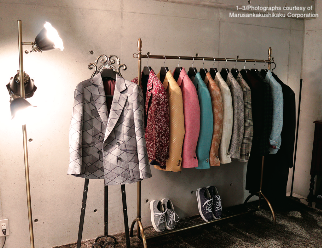
TJ: Are there other customers you remember in particular?
FUKUI: This was not someone with disabilities, but it was very difficult to make suits for a professional wrestler. The wrestler’s body was very muscular, but he had a thin waist, a thick neck, his shoul- ders were sloped and his hips were high. But these are just unique characteristics of that person. What I did for the wrestler was no different from what I did when I tailored for Mr. Tomioka. This is why I don’t think of “disabilities” when tailoring for people with such conditions. I just take their characteristics into account and tailor something that fits and is easy for them to wear.
TJ: Are there any challenges you are currently facing as a tailor?
FUKUI: Mr. Tomioka was only concerned about his leg, so it was rather easy to make the suit for him. But in order to make suits for people with various characteristics in the future, I would need to think harder about things, like how to make a jacket that is truly easy to wear for someone who can’t move their upper body. I once thought about making a jacket that separates into two parts, left and right, by attaching a zipper to the back. Of course, when seek- ing to accommodate every person’s body, there will be things I can and cannot do. But I don’t want to give up fashion nor functionality. Instead of saying, “I cannot do such a thing,” I want to say, “I think this much is possible, let’s do it.” I want to be able to accommodate all customers by having various tailoring options.
TJ: Hearing your story makes me want to order a suit for myself. I feel like it would be empowering to have a carefully tailored, one-of-a-kind suit for myself.
FUKUI: I want custom-made clothes to become a more accessible option. Because custom-made clothes don’t waste materials, they could be an effective solution to sustainable fashion, too. Many peo- ple might think of tailoring suits as a man’s tradition, but we are no longer in a time when such kinds of notions will persist. I want to create more suits to help people succeed in the world. At the base of this intention is my hope to create a world where everyone can love their own identity. For me, my atopic eczema is my identity, and now I cherish all the feelings and conflicts my condition had brought me. If I could make a society where one can love their characteristics as their uniqueness, I think this will lead to love toward others, sur- roundings and society.
Influencer/Graphic Designer
Sashimi-chan

Sashimi-chan, an influencer and a graphic designer, was diag- nosed with chondrodysplasia punctata, a congenital condition which has made a deformation in her spine, and she must use a wheelchair outside her house. What lies beneath her lifestyle and her strength to pursue her fashion with unique aesthetics and perspectives? She shares this and how she feels about the way society actually perceives people with disabilities, which has been becoming more visible through the backlash she recently received on online platforms.
TJ: Could you share with us how you started calling yourself “Wheelchair-gyaru” (gyaru is a term for Shibuya fashion subcul- ture and those who practice it)?
SASHIMI-CHAN: I’ve always loved expressing myself through fashion, so I had always dressed up in flashy clothes. One or two years ago, when I thought of what kind of impression I can make as an influencer, I started using the term “gyaru” since I loved Neo- Gyaru culture.
TJ: Is there any experience that has led you to prefer a flashy style?
SASHIMI-CHAN: I think the fact that my parents, especially my mom, liked flashy stuff could have been a big influence. I was someone who stood out simply by not doing anything because of my condition, so I feel that I have this underlying notion that I stand out either way, so why not stand out in a style I love. This could be some sort of antithesis I propose toward society. Other influences could be from KERA, a Harajuku-style fashion magazine that I used to read when I was in elementary and middle school, as well as the mangas by Ai Yazawa and Kyoko Okazaki. I really loved Harajuku- style fashion and music like punk and rock. My love got stronger as I became absorbed in them. Such days helped me understand my fashion and also made the value of expressing myself through fashion become deeply rooted in myself.
TJ: When did you first realize that you could express yourself through fashion?
SASHIMI-CHAN: When I was in my second year of middle school, I started dressing in Lolita fashion (a Japanese subculture fashion style influenced by Victorian clothing and Rococo culture), and that’s when I thought to myself, “I got this!” I think my mom asked me, “Why would you go out in such clothes?” But I did not give up my fashion at that time, nor have I given it up since then.
TJ: It seems like the range of options is limited when a wheelchair is involved. Have you ever felt disheartened by not being able to wear something you wanted to?
SASHIMI-CHAN: I never really thought of an option of giving up. Because I didn’t become disabled after being born, I don’t think I ever thought of myself as a person with a disability. Like someone who is curvy chooses plus-size clothes, I just choose the clothes that fit me. But to be honest, clothes that incorporate Universal Design don’t fit me. Or rather, there aren’t any that fit my taste. So right now, I think that it would be convenient to have a device that could help me get dressed by myself, such as a string that can let me move the zipper on the back [of an article of clothing]. In terms of clothes themselves, I want to select the ones according to my own plan and preference of design.
TJ: Even for those who can move their arms freely, there are zip- pers attached to places that are inconvenient. How do you use zippers?
SASHIMI-CHAN: When hanging out with friends, for example, I ask them, “Could you unzip this when we are saying goodbye to each other at the end of today?” I often forget to unzip it, come home drunk, try to do it myself and break it. But that doesn’t mean that I choose to not wear clothes with zippers on the back. I fix it if I break it. I first find clothes I like, and then afterwards I think of what I can do to look good in it.
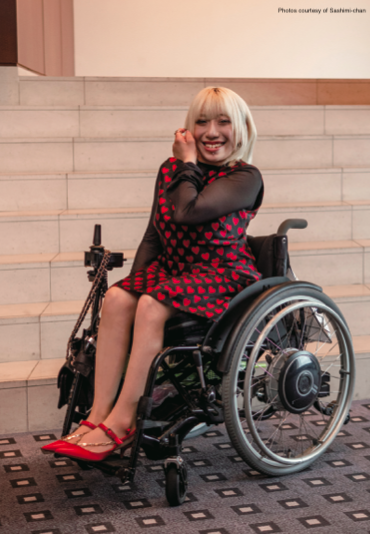
TJ: Does it feel empowering when you dress up in your favorite clothes?
SASHIMI-CHAN: In the past, I definitely used to feel like that, but nowadays I focus on enjoying it. Thinking things like, “Let’s become a cherry blossom since it’s spring,” or “Let’s dress up like that character from that TV show,” is so much fun. But recently, my Twitter post, which was about people cutting in line in front of me when riding elevators, provoked an unexpectedly heated debate. I received negative comments like, “I would not make way in the ele- vator for someone who uses a wheelchair with flashy clothing,” or “I would have let her in if her hair color was plain and wore something like a navy dress.” It became vividly clear to me that many people expect those who are vulnerable to behave like they are vulnerable. But I felt that I don’t need to be helped by such people, and I actually inversely felt more confident in my fashion.
TJ: Wow, I am amazed by your power to push back against the negativity from others.
SASHIMI-CHAN: Nowadays, I don’t even feel anything toward typical abusive comments like, “You’re disgusting,” or “Die.” The only comment that hurt me the most was, “This wheelchair is so bulky.”
TJ: ?!
SASHIMI-CHAN: When I was young, while everyone else was playing outside, I was using the small space right in front of me, drawing something or playing with building blocks. In fashion and interior design, too, I made it through by thinking how to make improvements in the space right in front of me. But the wheelchair is something I cannot do anything about. I really hate that. I can’t let people’s eyes be drawn toward the colorful tires of the wheel- chair rather than the clothes I chose. There are lots of wheelchair users who have a strong love toward wheelchairs, but as for myself, if I were asked, “Wheelchair or Louboutin?” I would immediately choose Louboutin.
TJ: What do you want to convey as an influencer in the future?
SASHIMI-CHAN: The most important thing is transportation infrastructure. It surprised me that the rule that wheelchair users have priority in elevators is not well-known. I think we need to make people aware of the order of priority. I would like to break down the notion that “if the weak don’t behave like the weak, we won’t help them.” There are people who are low-key even if they look flashy, and there are people who are arrogant even if they are plain. Helping each other has nothing to do with appreciation or disability.
TJ: Your posts will give someone a chance to get ahead in the future.
SASHIMI-CHAN: I want to keep posting. It is difficult to com- municate subtle feelings, but I hope that I can tell “There are various kinds of people” to as many people as possible.
日本の「障がい者ファッション」の “今”
取材・文|岸野 愛
日本は医療保険制度が手厚く、日常的な病気や怪我に対する不安が少ないとする見方がある。一方、障がい者に対す る意識やサービスでは欧米諸国に遅れを取ってきたとされる。その「障がい者に対する意識」が、この数年で少しずつ 変化を見せている。地道に活動を続けてきた人たちの力に加えて、「東京 2020 パラリンピック」での日本人選手の活躍、 人気俳優が障がい者を演じるテレビドラマの放映などが後押ししたのだろう。そして今、日本で新たに注目を集めつつあ るのが、SNS などで目にする機会が増えた障がい者のファッションである。障がい者とファッションの関係性を、それぞ れの立場から模索してきた人物3人にインタビュー。ファッションの在り方を通して見えてきたものは、いったい何か?
一般社団法人日本障がい者ファッション協会 代表理事
平林 景

スタイリッシュでありながら、ウエスト部分にマジックテープを 採用し、瞬時に着脱できる...。障がいの有無や性別・年齢問 わずに着用できる、機能性とデザイン性を兼ね備えた巻きスカー ト 型 の ボ ト ム ス 『 b o t t o m ' a l l 』( ボ ト モ ー ル ) を 生 み 出 し 、 注 目を集めた平林景。昨年、車椅子に乗ったモデルを起用した ファッションショーをパリで実現した、彼の展望とは。
TJ: そもそも、bottom'all でパリコレを目指したきっかけは?
平林: 2019 年に、一緒に食事をしていた友人から「車椅子の方がパリ コレのランウェイを歩いたことはないってご存知でしたか?」と聞かれ たんです。その頃の僕は、“オシャレで、障がいや福祉業界に対するイ メージを明るく華やかにすること” を自分のミッションだと考えていた ので、「嘘やろ!」と思ってすぐに調べた。すると、本当にその記述が 一切出てこなかった。すでに SDGs もメディアで取り上げられていたの に、「世界の目標と現実のギャップはまだこんなにあるのか」と衝撃を 受けたんです。そして、「車椅子のモデルがパリでランウェイを歩いた というだけでは、世の中は変わらないだろう」とも思いました。“車椅 子であってもオシャレができるデザイン” というマイナスをゼロにする ようなファッションではなく、“車椅子だからこそオシャレなデザイン” のファッションでショーができたら、障がいがあること自体が格好良く 見える逆転現象が生まれて、そのときにようやく世の中が少し変わるん じゃないかなと考えました。その方が、自分の時間と命を削って挑戦す る価値もある。翌日から早速その目標に向けて動き始めて、同年 11 月 に「社団法人日本障がい者ファッション協会(JPFA)」を立ち上げたの が始まりです。
TJ: その後、実現に至るまでにはどのようなプロセスを?
平林: まずは、服を作れる人を探しました。「こういう服があったらい いよね」というイメージはできていたけど、服を作った経験がなかった ので。すると、不思議と協力してくれる人たちが集まってきた。しかし、翌 2020 年はコロナ禍で活動をストップせざるを得なくなり、実際に服 を作り始めたのは 2021 年頃から。試行錯誤を繰り返しながら、同時に 会場選びも 1 年くらい時間をかけて、ようやく昨年実現できたという経 緯です。予算や会場の決定はかなり難航して、途中 3 回くらい頓挫し そうになりました。服作りのことも、パリコレのことも、何も知らない 状態からスタートしたことが逆に良かったんじゃないかな。100 人以上 の人たちが関わり支えてくれたのは、僕たちが「パリコレへの知識もな いし服も作れないけど、それでもやる」という熱意や想いに共感してく ださったからだと思う。「コイツ、放っておいたら大変なことになる!」 という心配や親心のようなものだったかもしれないけれど。

TJ: コロナ禍とはいえ、動き出そうとしたタイミングでストップを余儀 なくされたことにはもどかしさも感じたのでは?
平林: 今思えば動けなくなった期間も、必要な時間でした。「やるぞ!」 という勢いだけの状態から、「どんな言葉で自分たちの想いを発信して いくのがいいのか?」ということを、bottom'all を作っているメンバー たちとしっかり話し合えたので。そのときに生まれたのが、今も掲げて いる「Next UD(Next Universal Design)」というコンセプト。従来の ユニバーサルデザインは、誰もがアクセスできて使いやすい=ユーザビ リティの観点のみに終始しているような印象があった。僕らは、その上 に心躍るようなエンジョイビリティをプラスしたいし、それこそが次世 代のユニバーサルデザインにつながると思っています。
TJ: 実際にショーを開催したときの心境や発見を教えてください。
平林: 本当に面白かったです。ゼロを 1 に変えるためにパリに行きまし たが、実際のところは「ゼロを 0.1 ぐらいにできたかな」というのが率 直な感想。反響はあっても、「まだまだやるべきことがある」と実感さ せられた。でも、そのおかげで「Next UD Collection を実現させたい」 という次の目標も生まれました。今回出展したパリコレは世界4大コレ クションと呼ばれるファッションショーの 1 つですが、ユニバーサルデ ザインに特化したコレクションは世界にまだ存在しないらしいんです。 それが実現したときに、0.1 にしたものをやっと 1 にできるんじゃない かなと。すでにその目標に向けて、動き出しています。まだ、具体的に は言えないけれど、きっと面白いものを見せられるはずです。
TJ: 日本の障がい者ファッションの課題や社会への展望については、ど う考えていますか?
平林: 障がい者ファッションに通じるところで、近い未来に介護のファッ ション革命が起こると想像しています。なぜなら、1980 年代に日本で 流行した「デザイナーズ&キャラクターズブランド」を経験した世代の 方々が、介護を必要とする年齢に達するから。当時、ファッションブー ムに熱狂していたオシャレ好きな人たちに、「今の介護服や機能性だけ に特化した服を選ぶか」と問えば、「私は着ない」という人が多いんじゃ ないでしょうか。僕自身も嫌ですもん。そう考えると、僕らが今作って いる服は、自分たちが年を取ってどこか身体が動かなくなったときに着るものを作っていることに等しい。年を重ねると足が動かなくなったり、 身体の自由が利かなくなったりするわけじゃないですか。そうなると、 おのずと車椅子を選ぶ人が出てくるので、車椅子=障がい者の道具では なくなる。障がいと介護の分野は、非常に近しいものがあると思います。
TJ: 平林さんの服作りは、障がい者ファッションという枠組みに留まら ない、世の中の選択肢の 1 つを増やす取り組みとも言えますね。
平林: “選べる” ことが健全な世界だと思うんです。僕たちの最終目的 は、Next UD の服が世の中にもっと浸透すること。ふと手に取った服が、 誰かの手伝いを必要としない、当たり前のように自分で自由に着られて、 かつオシャレなものであってほしいということ、です。すべての服がそ うあるべきというわけではなくてね。選択肢が多い世の中にしていきた いですし、そういう時代になると信じています。
株式会社まるさんかくしかく 代表取締役
福井 彩恵

一人ひとりの身体の特徴に真摯に寄り添い、どんな人にも世界に 1 着の特別なスーツを仕立てるテーラー・福井彩恵。オーダー メイドの強みは、障がいを持つ人へのスーツ作りにどう生かさ れ、どんなスーツを作り上げたのだろう。彼女のこれまでの経 歴とテーラーとしての理想の在り方を聞くと、スーツ作りを通し て伝えたい想い、叶えたい社会が見えてきた。
TJ: 福井さんがテーラーとしての経歴をスタートさせたきっかけには、 長年、アトピー性皮膚炎に悩まされていた際の経験があるそうですね。
福井: はい。自分の身体のことなのに、自分の思う身体じゃない。人と 違う。なんであの子はあんなにきれいな身体やのに、私はこんなに醜い んだろうって。自分の人生も、生んでくれた親のことも恨んでいました。 成長するにつれてひどくなるパターンだったので、「このまま大人にな らなあかんのやったら、死んだほうがマシ」って本気で思ったこともあ りましたね。でも、ありがたいことに 30 代前半で克服することができ て、テーラーとして独立したのは 34 歳のときです。「スーツ作りを通し て、社会に対して何をしていきたいんだろう」と考えたら、自分の過去 の経験から「どんな人にも『あなたの人生は素晴らしいんだよ』という ことを伝えたいんだ」と思ったんですね。具体的に何をすればいいのか も分からなかったですし、「障がいをお持ちの方に対してスーツを作ろ う」ということも当時は思い付いていませんでした。ただ、ファッションを楽しむことが心に及ぼす影響って、ものすごく大きい。だから独立 当初は、障がい者就労支援 A 型事業所の方々と協力して、タイを作る 取り組みを行なっていたりしたんです。その過程で、身体に障がいのあ る方に対しても「オーダーメイドなんやから、“こうしたい” を作って あげられるやん」と、ふと思ったんですよね。
TJ: そこから、アンプティサッカー日本代表やカヌー競技選手として活 躍される冨岡忠幸さんのスーツを仕立てることにつながるんですね。
福井: そうなんです。知り合いにアンプティサッカーチームの監督を務 める方がいて、そのご縁で冨岡さんにお会いしました。大阪のサロンに 来ていただいて、たくさんお話を伺って作っていきましたね。
TJ: 具体的には冨岡さんとどんな意見交換を経て、スーツを完成させた のでしょうか?
福井: 冨岡さんは「左脚の付け根の部分から義足なので、とにかく既製 品のパンツは脱ぎ着がしづらい。でも、オシャレは好きだからかっこよ く着こなしたい」とおっしゃっていて。どう工夫をすれば履きやすくな るのかを、一緒に考えさせてもらったんですが、意外にも解決法は難し くなかったんですよ。両足それぞれの太さに合わせて筒周りを調整する こと、ウエストをゴムに変更すること、パンツの裾にジップを付けるこ と、そのくらい。本当に小さな工夫で着られる・着られないが分かれる というのが大きな発見でした。既製品でもできないことはないけれど、「オーダーメイドだからこそ細かい希望を伺うことができた」と思って います。作る側としては、「もっと巧みにディテールを工夫しなければ いけないかも」と思っていたんですけどね。あまり小難しく考えずシン プルでいいし、「オーダーメイドだからこそ、1 つ1つの工夫をその人 に合わせられることが私の強みやな」と実感できました。

TJ: これまでのスーツ作りの中で、他にも印象に残っている方はいます か?
福井: 障がいの方ではないのですが、プロレスラーの方のスーツは難し かったですね。筋肉ムキムキだけど腰は細くて、首の筋肉があってなで 肩で、ヒップの位置はとても高くて。でも、それもその方の身体の特徴 でしかないんですよね。私がやることは、冨岡さんのスーツを仕立てた ときと何も変わらない。だから、「障がいのある方にも対応しよう」と いう感覚は、今もそんなにないんです。ただただ、その人の特性と向き 合って、その人の体に合った着やすいものを仕立てることだけだなって。
TJ: では今、テーラーとして課題に感じていることはありますか?
福井: 冨岡さんは不自由に感じている部分が脚だけだったので、どちら かというと作りやすかったように思うんです。でも今後、あらゆる方の 特徴に合わせたスーツを作るためには、もっと頭をひねらないといけな いだろうなと。たとえば、「上半身が動かない方にとって、本当に着や すいジャケットはどう作ればいいのか」とか。一度、背中にジップを付 けて、右と左の身頃がバサっと 2 つに分かれてしまうジャケットを作ろうかって考えたこともあります。もちろん、1人1人の身体に合わせる ことを突き詰めると、できることとできないことが出てくることでしょ う。でも、オシャレも機能性も諦めないために、「そんなんできません」 じゃなくて、「ここまでだったらできると思うからやりましょう」って 言える自分でいたい。どんなお客様が来られても対応できるように、「作 り方の選択肢はたくさん持っていたい」と思っています。
TJ: お話を伺って福井さんにスーツをお願いしたくなりました。世界に 1 着の、自分のためだけに大切に仕立てられたスーツを持っていれば、 とても心強い気がします。
福井: オーダーメイドの服が、もっと気軽に、選択肢の 1 つとして広まっ ていってほしいです。布を無駄にしないので、ファッションロスの深刻 な問題に対してもすごく有意義なはずです。スーツを仕立てる=男性と いうイメージが強いと思うんですが、これからの時代はそういうもので もないですよね。もっとたくさんの方の活躍を後押しできるようなスー ツを作りたいですし、その根本にあるのは「みんなが自分のアイデンティ ティを愛せるような世界を作りたい」という想いです。私自身、アトピー の疾患も自分のアイデンティティだったし、疾患があるがゆえに生まれ た感情や葛藤は、「全部宝物やな」って今は思えているんですよ。「それ が自分の個性だ」と愛せるような社会を作れたら、相手や周り、社会を 愛することにもつながるんじゃないかなと考えています。
インフルエンサー/グラフィックデザイナー
さしみちゃん

先天性の病である点状石灰化骨異形成症により、背骨が変形。 自宅以外では車椅子に乗って生活している、インフルエンサー /グラフィックデザイナーのさしみちゃん。独自の美学と視点を 持ち、自分らしいファッションを貫く彼女の強さ、生き方の根幹 にあるものとは。“炎上” によって見えてきた、障がい者に向け られるリアルな眼差しについての想いも届ける。
TJ: " 車椅子ギャル” を自称するようになった理由を教えてください。
さしみちゃん: もともとファッションで表現することがすごく好きで、 ずっと派手な見た目をしていたんです。そして 1 〜 2 年前、インフルエ ンサー活動をするにあたって「印象付ける “何か”」を考えて、ネオギャ ル文化が好きだったので、“ギャル” という言葉を使い始めました。
TJ:派手なスタイルを好むようになった原体験はありますか?
さしみちゃん: 両親、特にお母さんが派手好きだったことが大きいかも。 私は、病気のせいで何もしなくても周りから浮いちゃう存在だったので、「どうせ目立つなら好きな格好で目立ってやろう」という気持ちが根底 にある気がします。ある種、社会へのアンチテーゼですね。小中学生の頃に読んでいた原宿系ファッション雑誌の『KERA』と、矢沢あいさん や岡崎京子さんの漫画の影響もありそうです。原宿系ファッションやパ ンク、ロックといった音楽が本当に好きでした。のめり込むことで強く なった気もして。そんな日々の積み重ねで、好みの服を知り、ファッショ ンで自己表現する考えが根付いたように思います。
TJ: ファッションで自分を表現できたと、初めて実感できたのはいつで したか?
さしみちゃん: 中学 2 年生くらいのとき、全身をロリータファッション で包んだときは「やったるぞ!」と思いましたね。お母さんには「なん でそんな格好で出かけるの」と言われた気がするんですが、好きなファッ ションを諦めたことはそのときもこれまでにもないです。
TJ:車椅子での移動を考えると、服の選択肢が狭まりそうです。好きな 服が着られず、心が折れたことは?
さしみちゃん: 諦める選択肢は、私には本当になかった。中途障がい者 ではないので、自分が障がい者だという自覚がなかったんだと思います。 肉付きのいい方がプラスサイズの服を選ぶのと同じ感覚で、私も自分に 合う服を探すだけ。でも、正直なところ、ユニバーサルデザインを意識 した服は自分には合わない、というか、好みのものがないという印象で す。だから今は、「独りで着る手助けをしてくれる、便利アイテムがで きたらいいのに」と思っています。たとえば、背中のファスナーを動か しやすくしてくれる紐とか。服自体は、好きなブランドで好きなデザイ ンを選びたいですから。
TJ: 腕が自由に動く人でも上げ下げしづらい位置にあるファスナー、あ りますよね。さしみちゃんはどうしているんですか?
さしみちゃん: たとえば、一緒に遊んだ友達に「今日、帰る前に私のファ スナーを下ろしてね」ってお願いするんですよ。酔っ払って下げ忘れて 帰ってきて、仕方なく自分で外そうとして壊したことは何度もあります が。かといって、背中ファスナーの服を選ばない選択はない。壊れたら 修理しますし、まずは好きな服を見つけて、着こなすためにどうしたら いいかは後から考えます。

TJ: 好きなファッションに身を包むことで自分を武装、鼓舞している感 覚はありますか?
さしみちゃん: 昔はそういった感覚も強かったんですが、最近は “楽し む” ことにフォーカスしています。春だから桜になろうとか、ドラマの 登場人物のイメージで服を選んでみようとか、テーマを決めてコーディ ネートするのが楽しい。でも少し前、エレベーターでの割り込みについ て投稿した動画付きのツイートが、想像以上に話題になってしまった。「派手な服装の車椅子ユーザーには、エレベーターを譲りたくない」と か、「髪色が地味で、紺色のワンピースでも着ていれば譲ってやったの に」とか、見た目に関して否定的なコメントがたくさん届きました。「弱 者は弱者らしくあるべきだ」と考えている人の多さをまざまざと感じた んです。けれど、「そんな人には譲ってもらえなくていい」と思ったし、 逆に自分のファッションに自信が付きましたね。
TJ: マイナスを跳ね除ける、力強さに驚きます。
さしみちゃん: もはや「キモい」「死ね」みたいな定番の悪口は、何と も思わないですね。唯一、今回の炎上で傷ついたのは「車椅子、ゴツい な」というコメントです。さしみちゃん:子どもの頃、みんなが外で遊んでいたとき、私は絵を 書いたりブロックで遊んだり、目の前の小さな空間で遊んでいました。 ファッションやインテリアも同じで、目の前の世界をいかに良くするか を考えながら生きてきた。でも車椅子だけは、自分でどうにもならない。 それが、本当に嫌なんですよ。自分が選んだ服より、カラフルなタイヤ に目が奪われてたまるかと思います。車椅子に乗ることは、私にとって 自分の美学との戦いでもある。車椅子ユーザーには車椅子愛が強い方も たくさんいますが、車椅子か “ルブタン” かと問われたら、私は真っ先 にルブタンを選びますもん。
TJ: !?
さしみちゃん: 子どもの頃、みんなが外で遊んでいたとき、私は絵を 書いたりブロックで遊んだり、目の前の小さな空間で遊んでいました。 ファッションやインテリアも同じで、目の前の世界をいかに良くするか を考えながら生きてきた。でも車椅子だけは、自分でどうにもならない。 それが、本当に嫌なんですよ。自分が選んだ服より、カラフルなタイヤ に目が奪われてたまるかと思います。車椅子に乗ることは、私にとって 自分の美学との戦いでもある。車椅子ユーザーには車椅子愛が強い方も たくさんいますが、車椅子か “ルブタン” かと問われたら、私は真っ先 にルブタンを選びますもん。
TJ: では、今後インフルエンサーとして発信したいことは何ですか?
さしみちゃん: 一番は交通インフラです。今回の炎上で、エレベーター では車椅子ユーザーが優先されるルールが、こんなにも知られていない んだなと驚かされました。優先順位を周知していかなければいけないな と。「弱者が弱者たる態度を取らなければ助けない」みたいな考え方は どんどん壊していきたい。派手な見た目でも低姿勢な人はいるし、地味 でも横柄な人はいる。助け合うことに感謝があるか否か、障がい者か否 か、はまったく関係ないんです。
TJ: さしみちゃんが発信し続けることで、気付くきっかけをもらえる人 はたくさんいます。私も含めて。
さしみちゃん: これからも発信を続けていきたい。想いを伝えることは、 そのさじ加減がすごく難しいんですが、「社会にはこういう人間もいる んだよ」ということを少しでも多くの人に伝えられたら、と思っていま す。
The complete article can be found in Issue #282 of the Tokyo Journal.




























